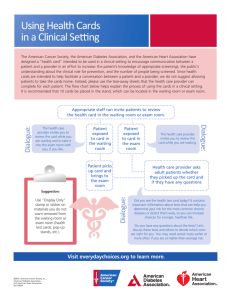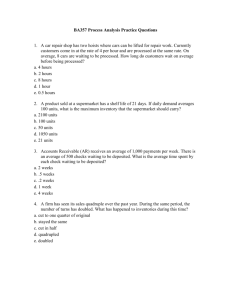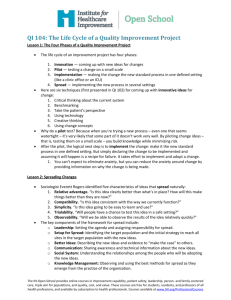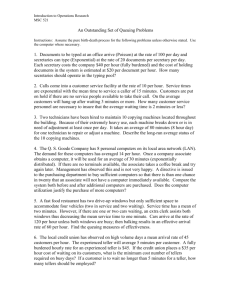A Novel Cross-Layer Dynamic Integrated Priority
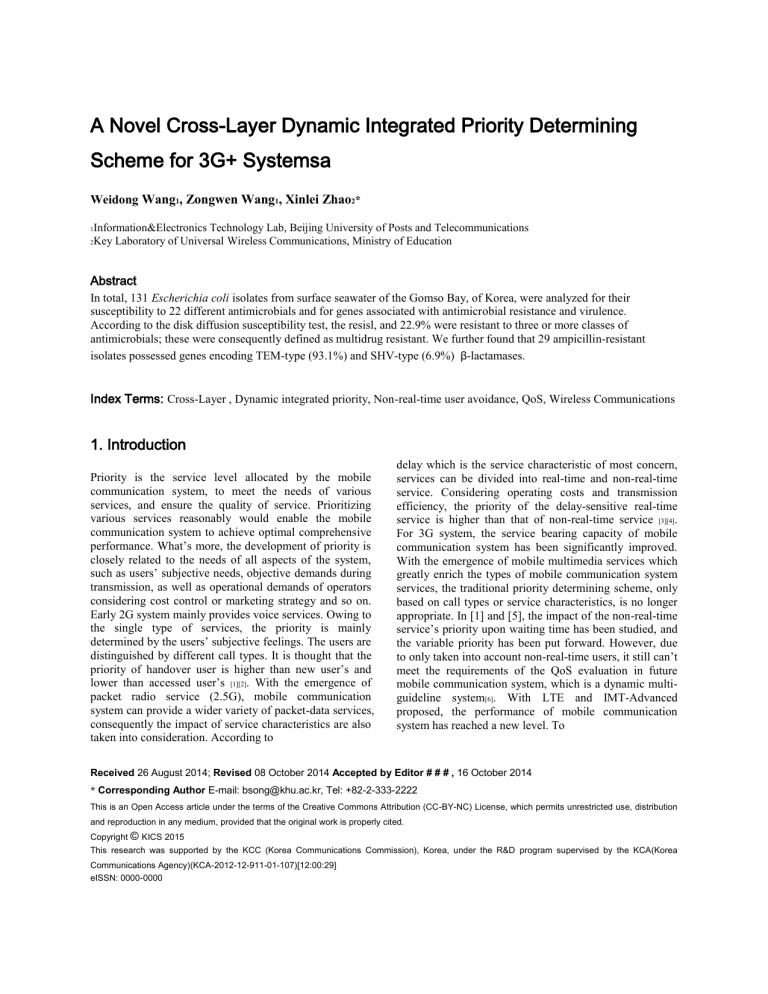
A Novel Cross-Layer Dynamic Integrated Priority Determining
Scheme for 3G+ Systemsa
Weidong
Wang
1
, Zongwen Wang
1
, Xinlei Zhao
2
*
1
Information&Electronics Technology Lab, Beijing University of Posts and Telecommunications
2
Key Laboratory of Universal Wireless Communications, Ministry of Education
Abstract
In total, 131 Escherichia coli isolates from surface seawater of the Gomso Bay, of Korea, were analyzed for their susceptibility to 22 different antimicrobials and for genes associated with antimicrobial resistance and virulence.
According to the disk diffusion susceptibility test, the resisl, and 22.9% were resistant to three or more classes of antimicrobials; these were consequently defined as multidrug resistant. We further found that 29 ampicillin-resistant isolates possessed genes encoding TEM-type (93.1%) and SHV-type (6.9%)
β
-lactamases.
Index Terms:
Cross-Layer , Dynamic integrated priority, Non-real-time user avoidance, QoS, Wireless Communications
1. Introduction
Priority is the service level allocated by the mobile communication system, to meet the needs of various services, and ensure the quality of service. Prioritizing various services reasonably would enable the mobile communication system to achieve optimal comprehensive performance. What’s more, the development of priority is closely related to the needs of all aspects of the system, such as users’ subjective needs, objective demands during transmission, as well as operational demands of operators considering cost control or marketing strategy and so on.
Early 2G system mainly provides voice services. Owing to the single type of services, the priority is mainly determined by the users’ subjective feelings. The users are distinguished by different call types. It is thought that the priority of handover user is higher than new user’s and lower than accessed user’s
[1][2]
. With the emergence of packet radio service (2.5G), mobile communication system can provide a wider variety of packet-data services, consequently the impact of service characteristics are also taken into consideration. According to delay which is the service characteristic of most concern, services can be divided into real-time and non-real-time service. Considering operating costs and transmission efficiency, the priority of the delay-sensitive real-time service is higher than that of non-real-time service
[3][4]
.
For 3G system, the service bearing capacity of mobile communication system has been significantly improved.
With the emergence of mobile multimedia services which greatly enrich the types of mobile communication system services, the traditional priority determining scheme, only based on call types or service characteristics, is no longer appropriate. In [1] and [5], the impact of the non-real-time service’s priority upon waiting time has been studied, and the variable priority has been put forward. However, due to only taken into account non-real-time users, it still can’t meet the requirements of the QoS evaluation in future mobile communication system, which is a dynamic multiguideline system
[6]
. With LTE and IMT-Advanced proposed, the performance of mobile communication system has reached a new level. To
Received
26 August 2014;
Revised
08 October 2014
Accepted by Editor # # # ,
16 October 2014
* Corresponding Author
E-mail: bsong@khu.ac.kr, Tel: +82-2-333-2222
This is an Open Access article under the terms of the Creative Commons Attribution (CC-BY-NC) License, which permits unrestricted use, distribution and reproduction in any medium, provided that the original work is properly cited.
Copyright
©
KICS 2015
This research was supported by the KCC (Korea Communications Commission), Korea, under the R&D program supervised by the KCA(Korea
Communications Agency)(KCA-2012-12-911-01-107)[12:00:29] eISSN: 0000-0000
survive in the fierce market competition, the operator must improve user satisfaction which is the key point, and need a reasonable mechanism to determine priority which is an interest trade-off between subscriber and networks or other aspects.
Therefore this paper proposes a novel cross-layer dynamic integrated priority determining (DIPD) scheme, which determines the priority based the factors from every parts of mobile communication system.
2. Dynamic Integrated Priority
Determining Scheme
2.1 Priority Cross-layer design
With the development of IP technology, mobile communication system can provide users with more flexible and diverse services. For priority determining scheme, there are more new features in 3G and beyond 3G mobile communication system than previous communication system:
1 ) Complexity. The priority determining is based on subscriber call types (SCT) and service characteristics (SC) in former 2G system and 2.5G system. However in
3G/beyond 3G system there are more influencing factors which are not isolated from each other. Priority determining scheme should take them into account comprehensively. A handover user, who is browsing a web page, may have a lower priority than a new voice user.
2 ) Dynamic. Future mobile communication system can provide more plentiful services which result in higher demands on QoS. So priority differentiation must be more considerate which should reflect the changes of QoS needs and transmission and meet the requirements of the dynamic multi-guideline QoS scales. Therefore, the priority determining scheme should be dynamic and reflect the service status in real time.
3
)
Fairness. Non-real-time service occupies quite large proportions in the future wireless communications.
However, to improve the transmission efficiency, the existing systems may provide the necessary resources for real-time service by means of non-real-time service’s avoidance. The avoidance, which is achieved at the expense of non-real- time service, reduced the customer satisfaction. The priority determining scheme should protect the interest of non-real-time service as well, therefore should adjust the priority relationship between real-time and non-real time users, to avoid excessive non-realtime service avoidance phenomena.
In summary, various aspects of system should be taken into consideration in determining priority in future communication system comprehensively, such as network state, service requirements, user requirements. These aspects reflect in different layers of the wireless networks protocol stack as shown in Fig 1. From the perspective of cross-layer, this paper makes full use of the layer information interaction to determine the appropriate priority for scheduling control in terms of QoS requirements in application layer, channel condition in physical layer, delay limits in network layer, etc.
2.2 Factors Influencing Priority
In the existing researches, the influences of SCT and SC have been studied, and this paper will not illustrate them again. For the influence of waiting time, this paper will make a more comprehensive study and take movement mode and traffic load for example to explain the influence of novel factors on priority. First, waiting time influences priority. In the light of the fact that real-time service is more sensitive to waiting time than non-real-time service, the former’s priority is enerally higher than the latter’s.
But on one hand real-time service can tolerate waiting time to some extent, on the other hand the requirement for waiting time of non-real-time service is limited. For instance, the maximum delay of on-line game is 250ms, which means that service can be met when waiting time is lower than 250ms.But for web browsing it can only put up with 4s per page to the full, which means the waiting time
can’t exceed
4s per page. Future communication system will provide more flexible and rich services. In terms of the differences on tolerance against delay, the service classes are further divided in IMT–Advanced. Conversational service is composed of basic, rich and low delay. Interactive service is divided into low delay and high delay. Live and nonlive service classes come from streaming service
[7]
. Delay requirements of various services are different. Service can be served normally so long as waiting time doesn’t exceed the maximum delay.
Therefore priority should be adjusted by the urgency of service according to waiting time. More urgent it is, more preferentially it should be served. Through the role of waiting time, priority is dynamically adjusted between various services. The priority of non-real-time service might be higher than that of real-time service.
Secondly, movement mode influences priority. During transmission, user’s movement mode is varied, so is the channel condition. Compared to low-speed and stationary user, Doppler frequency shift caused by high-speed user is more serious. What’s more, high-speed user is prone to frequent handover. So, to enhance system performance, user movement mode is also needed to be taken into account. Thirdly, traffic load influences priority. Services have dif ferent service bandwidth requirements.
Broadband service needs more cell networks resources, which is inclined to result in targeted cell congestion. The network overloading may offer a broadband service at the expense of several narrowband services. Therefore, the service priority should be adjusted reasonably according to the traffic load. Under the same condition, narrowband service is given preference to guarantee system performance.
To sum up, the priority should be determined by combining the above factors which can be informed from different layers of network model, as show in Fig1. The impact of SCT is reflected in the process of access control or handover control, and the information can be acquired from transport layer and link layer. What we commonly refer to as SC is actually QoS parameters, such as transfer rate, delay, etc., which can be informed from application layer. Waiting time comes from the combination of transport layer and network layer, and movement mode can be got according to channel condition and transmitting power which are from physical layer. The impact of traffic load on cell is reflected in network layer, link layer and physical layer.
The impacts of above factors upon priority are different, and it is necessary to consider them jointly. For SCT and
SC, they reflected the most basic priority requirements of the service and can be called Intrinsic Factors (IF). Once be selected, they would not change during the service process. For waiting time, movement mode and traffic load state, they reflect the impact of users’ subjective needs and objective environmental changes, which are changing during the communication process, that is,
Dynamic Factors(DF). Combining IF and DF, the priority can be determined accurately, that is, Dynamic Integrated
Priority (DIP). DIP is a comprehensive reflection of the impact of the network environment, service and users. For the priority determined by IF , service 1 is higher than service 2 as dotted line shown in Fig 2. However, due to the impact of DF, the priority of these two services is changing all the time along with service proceeding like the real line. At some time, such as A, B region, the priority of service 1 exceeds service 2. The architecture of DIP is shown in Fig
3.
2.3 Dynamic Integrated Priority Computing
Dynamic integrated priority refers to the priority used as standards for serving. In the state waiting for being served, user priority changes along with intrinsic factors
(subscriber call types and service characteristics) and dynamic factors (waiting time, movement mode, as well as traffic load). For comprehensively considering various factors DIPC is different from traditional judging methods.
The primary principle of DIPC: service priority in queue is dynamically adjusted, which is realized at the base station for scheduling. Not only considering the influence of intrinsic factors on priority, but also comprehensively considering dynamic factors to calculate priority periodically, to identify service priority in different transmission circumstances.
① Defines i
[8]
P i,sc as service characteristic priority for user
Where R i means maximum transfer rate,
λ i is average throughput. When user i is on real-time service,
α i is determined by
δ i
(packet dropping rate), T i
(the maximum tolerant delay). Or it is just set as the appropriate weight z i to guarantee sufficient bandwidth for non-real-time service’s access.
② Define P i,sct as subscriber call type priority for user i .
And
β1
,
β2
,
β3 separately represent the different weighted value for accessed user, handover user, and new user, where
β1
>
β2
>
β3
.
③ Define Pi , queue as waiting time priority of user i
Where, T wait is the waiting time of user i , T max means the maximum waiting time that user can tolerate. When T max exceeds a certain threshold, the affect will increase by power function. n in the equation(2) varies according to different situations. K is a variable which means the weighted value of different services, k1 > k2 for real-time service as k1, non-realtime service as k2 .
④ Define P i,speed as movement mode priority. And
ε1
,
ε2,
ε3 separately represent different weighted value of highspeed user, low-speed user and stationary user, where
ε1
>
ε2
>
ε3
.
⑤ Define P i,trafficload as different traffic-load priority of user i. And
η1
,
η2 separately represent different weighted value according to whether remaining resources can satisfy the required resources, where
η1>η2
. When met,
η1 is chosen, or
η2 is chosen. User priority is eventually codetermined by five factors mentioned above, as follows:
3. Simulation and Analysis
Assuming OFDM system has 5MHz bandwidth and 512 numbers of sub-carriers. There are four types of services, such as real-time low-speed, real-time high-speed, nonreal-time low-speed, non-real-time high-speed, which respectively occupies 1, 20, 4, 30 sub-carriers. As the flow characteristics of each cell will be the same after the system has run long time, if the number of sub-channels allocated to each cell is the same and fixed. Hence, the performance of one of the reference cell is just needed to be analyzed
[13][14]
. Under the premise of meeting new user blocking rate and handover dropping rate, DIPD guarantees fairness between real-time service and nonreal-time service with considering waiting time.
4. Conclusion
This paper proposes a novel Dynamic Integrated Priority
Determining (DIPD) scheme and establishes a set of dynamic integrated priority structure by comprehensively taking multiple factors into account based on cross-layer design, which can be used for future mobile communication system. Priority is codetermined by SC,
SCT, waiting time, movement mode and traffic load state, and meets various services and users’ needs. The simulation results show that the proposed scheme effectively improves system performance by fairness guarantee and reducing NRT avoiding dropping rate. The handover dropping rate and blocking rate are reduced employing DIPD scheme, and the throughputs are increased.
Acknowledgements
This work was supported by the National S\&T Major
Project (2010ZX03002-008-01) and the National Natural
Science Foundation of China under Grant 60672131.
References
[1] Ariton E. Xhafa, Qzan K .Tonguz. Dynamic Priority Queuing of Handover Calls in Wireless Networks: An Analytical
Framework[M]. IEEE JSAC, 2004,22(5): 904~916
[2] Duk Kyung Kim, Dan Keun Sung. Handover management in
CDMA system with a mixture of low rate and high rate traffics [C].
VTC, 1998.1346~1350
[3] Li Jian, Hu Bo, “Multi-service handoff algorithm used in multicarrier wireless cellular communication system [J],” Journal on Communications, 2007, Vol.28, No.3
[4] LI W, CHEN H, AGRAWAL D P. Performance analysis of handoff schemes with preemptive and nonpreemptive channel borrowing in integrated wireless cellular networks[J]. Wireless
Communications, IEEE Transactions on, 2005, 4(3):1222-1233.

